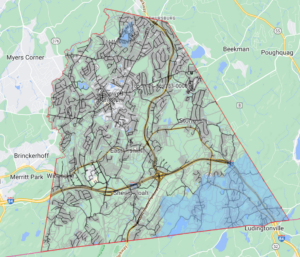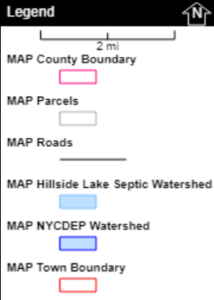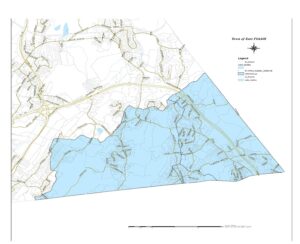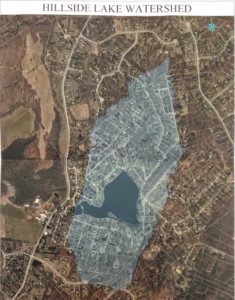NYSDEC PHASE II STORM WATER REGULATIONS
Water is one of our most valuable resources. Not only our drinking water, but also our natural resources such as waterbodies, watersheds, floodplains and wetlands. It is very important that we protect and prevent various pollutants from discharging into our water resources through stormwater runoff. Clean water is essential to the entire community and for the protection of our environment and wild life. The Town of East Fishkill has adopted multiple standards to protect water quality within our community through the development of a Stormwater Management Program.
Report Stormwater issues to: Town of East Fishkill MS4 Officer (845) 221-2681
In compliance with the EPA’s Phase II Stormwater Rule the Town of East Fishkill was designated as an MS4 (Municipal Separate Storm Sewer System) by the New York State Department of Environmental Conservation in 2003. As a regulated MS4 the Town of East Fishkill has developed and implemented a SWMP utilizing six minimum Control Measures (MCMs). The six MCM’s include:
This measure includes distributing educational materials and performing outreach to inform citizens about the impacts that polluted stormwater can have on environmental and water qualities. Municipalities shall describe steps to reduce stormwater pollution and inform households and individuals on proper septic system maintenance, limiting use of runoff from garden chemicals, local stream restoration, etc. Information should also be directed to targeted groups such as commercial, industrial and institutional entities. The municipality should address the viewpoints and concerns of all sub-communities.
This measure includes citizens to participate in program development and implementation, public hearings and/or encouraging citizen representatives to participate in the MS4’s SWMP. The MS4 shall encourage community participation and volunteers to work with, and assist with ongoing implementation of its SWMP.
This measure includes developing and implementing a plan to detect and eliminate illicit discharges to the storm drain system. This includes developing system mapping and informing the community of hazards associated with illegal discharges and improper waste disposal. Mapping should show the location of major pipelines, outfalls and topography, areas of concentrated activities likely to be sources of storm water pollutants such as recreational areas and define watershed boundaries. Municipalities must effectively prohibit illicit discharges into MS4 systems through the use of ordinances, orders, and implement enforcement procedures and actions. The municipality must identify illicit connections into the storm sewer system, de3velop a plan to detect illicit discharges/dumping, and must inform public employees, businesses and citizens of hazards arising from illegal discharges.
This measure includes developing a plan to reduce storm water pollution from construction activities and developing, implementing and enforcing an Erosion and Sediment Control program or ordinance for construction that meets or exceeds the requirements set forth in New York State Department of Environmental Conservation SPDES General Permit GP-0-20-001 for stormwater Discharges from Construction Activities that involve disturbance of one or more acres of land. This measure must include requirements for construction site owners, operators and contractors to implement Best Management Practices (BMP’s), a comprehensive pre-construction review of site plans with recommendations, procedures to receive and consider public input, regular inspections of BMP’s during construction. Violations shall result in penalties to insure compliance.
This measure includes developing, implementing and enforcing a program to address post-construction storm water runoff from development and redevelopment areas that disturbed land greater than or equal to one or more acres and project sites discharging into MS4’s. This program must include site appropriate, cost-effective structural and non-structural BMP’s that emphasize management and source controls. This program should be based on local watershed planning and measures to prevent or minimize water quality impacts and to insure the long-term operation, inspection and maintenance of BMP’s. The Environmental Protection Agency (EPA) recommends BMP’s that minimize negative water quality impacts and maintain pre-development runoff conditions.
This measure includes developing and implementing a program of your infrastructure, operations, and maintenance with the goal of preventing and reducing pollutant runoff from municipal operations. This program must include municipal staff training on pollution prevention measures. Municipalities must provide municipal employee training with regard to parks, open space maintenance, fleet maintenance, building management, storm drain system maintenance and the proper disposal of waste removed from the storm drains. Controls should be implemented for reducing pollutants from streets, parking lots, corporation yards and solid waste operations.
Helpful Links
National Menu of Best Management Practices (BMPs) for Stormwater | US EPA
Town of East Fishkill, NY Storm Sewers
Town of East Fishkill, NY Stormwater Management and Erosion and Sediment Control
TOWN OF EAST FISHKILL MAP


The Watershed You Live in
A watershed is the land where all of the water that is under it or drains off of it goes into the same place.
The Town of East Fishkill has two designated watershed areas. The Hillside Lake Watershed located in Wappingers Falls, New York and the New York City / East of Hudson Watershed located in Stormville, New York.
Everywhere within the mapped boundaries of the watersheds including, streams, roadside ditches, and even the water that runs over your lawn during and after a rain all ends up flowing to one place within each watershed.
The New York City / East of Hudson Watershed receives all the drainage and stormwater runoff within the watershed which subsequently flows into New York City’s drinking water supply.
The Hillside Lake Watershed also receives all the stormwater runoff from everywhere within its mapped boundaries, which then flows into Hillside Lake.
New York City / East of Hudson Watershed
Stormville, NY

Hillside Lake – Fishkill Creek Watershed Area
Wappingers Falls, NY

Best Management Practices
Best Management Practices (BMP’s) are methods, measures or practices employed to prevent or reduce water pollution. They can be divided into two types: Structural BMPs, which are constructed practices such as the installation and catch basins, grass swales or detention ponds, and Cultural BMPs, which are methods, measures or practices that affect or change an individual’s behavior, such as proper usage and disposal of household products and good housekeeping.
TIPS FOR HOMEOWNERS WITH SEPTIC SYSTEMS
Please contact MS4 Officer Joe Oakes (845)221-2681 with any comments regarding the 2024 MS4 Annual Report/ Interim Progress Certification 2025 DRAFT